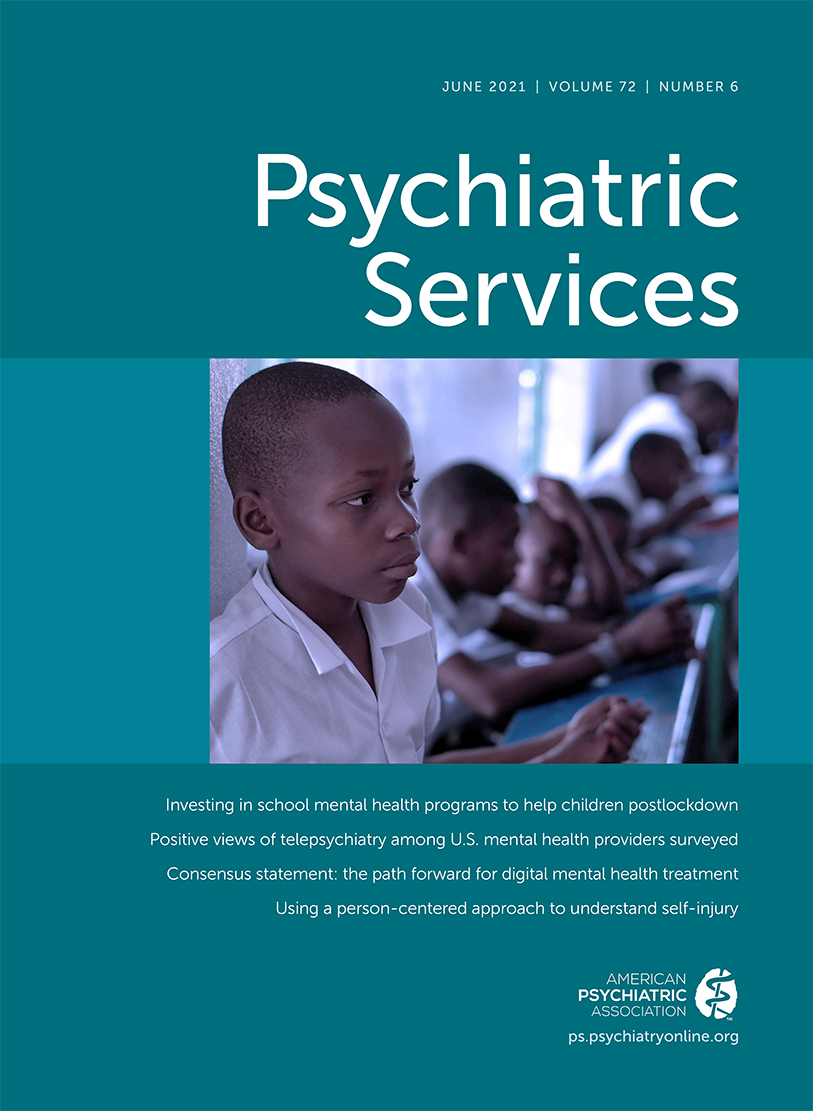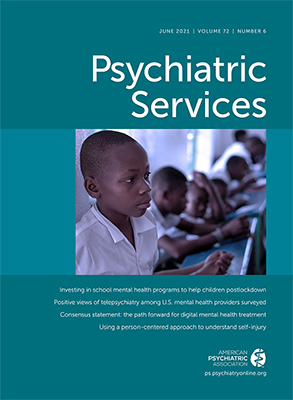The report by Avalone et al. (
1) in this issue of
Psychiatric Services is important. It should be used as further evidence supporting policy changes enabling the long-term widespread reimbursement of telepsychiatry (audio and video) as a mode of delivering mental health visits electronically, such as proposed by the American Psychiatric Association (
2).
In an elegant and concisely presented retrospective study from New York, the authors described three important telepsychiatry (audio and video) findings in a large group of racially diverse, mainly low-income patients who had a high level of serious mental illness. First, Avalone et al. demonstrated that low-cost and easy-to-access telephony could be used to maintain the care of this cohort in their homes in an urban setting during the COVID-19 pandemic. Second, the telephony group of patients was more racially diverse and more likely to be on Medicare or Medicaid than the in-person treatment group, suggesting that telephony facilitated improved access to and equity of care for underserved populations in this urban region. Third, there were fewer appointment no-shows in the telephony group; these patients had a considerably greater likelihood of completing their mental health visits using telephony compared with those using in-person care during the pandemic or during a pre–COVID-19 comparison period.
I examine these three findings in detail, because they have significant implications for the way clinicians provide care, and for how it is reimbursed, both during and after the COVID-19 era.
Undoubtedly, COVID-19 has led to massive disruption in mental health systems worldwide, but it has also created opportunities for change. One of these changes has been the rapid expansion of telepsychiatry programs, specifically the use of, and reimbursement for, audio-only consultations, as described by Avalone et al. (
1). Historically, telepsychiatry programs have primarily used videoconferencing because this modality was more likely than other modalities to be reimbursed, but programs have recently been able to integrate telephone (audio-only) consultations in the United States after a broadening of reimbursement policies associated with the COVID-19 Emergency Declaration (
2). Numerous U.S. examples have since been described where previously traditional in-person outpatient psychiatric clinics, both public and private, have changed to fully virtual operations (
3). Most of these virtual clinics have primarily used video consultations, with audio-only as a backup when technical problems occur or when patients have no access to video technology or cannot or do not wish to use it. In the United States, most outpatient psychiatrists, and other mental health providers, have probably been using videoconferencing and/or telephony for some or all of their patients since March 2020, with many using guidance from the comprehensive American Psychiatric Association Telepsychiatry Toolkit (
4). Avalone et al. (
1) have extended this virtual clinic concept and have described the first large cohort of patients treated primarily via audio consultations. Most of the patients were likely already known to their providers, and this approach seems to have worked well clinically. More trials are necessary, and doubtless other papers from the COVID-19 era will be published on this topic. Now, however, the data from Avalone et al. support the need to reimburse mental health professionals for audio-only consultations, where they are carried out in appropriate clinical situations, as well as for telepsychiatry (video and audio) to be reimbursed in urban regions in the “new normal” post–COVID-19 era.
The report’s second finding, of the importance of the increased racial diversity and likely low incomes in those treated with telephony, extends from the first. We know that prior to the pandemic, none of the audio or video visits reported by Avalone et al. would have been reimbursed, because the visits did not occur in rural areas. New York City is certainly not rural. From March 2020 onward, we know that there has been a dramatic increase in the number of reimbursed telepsychiatry (audio and video) consultations occurring nationally. Estimates are available of the number of insurance-paid medical consultations for telehealth, of which about half are for mental health from primary care practitioners and psychiatrists/psychologists (
5). These estimates suggest a national monthly increase by September 2020 of about 3,000% in video and audio mental health consultations, compared with September 2019. These figures also show that nationally about two-thirds of telepsychiatric consultations are occurring in metropolitan regions not previously reimbursed by Medicare. Of course, most patients with serious mental illness live in these areas, as do large African American and Hispanic populations, who were previously not able to receive any telepsychiatry consultations, audio or video, with their providers. Now that Avalone et al. (
1) provide evidence that phones give racially diverse metropolitan groups better access to care than even in-person alternatives and that most telehealth consultations nationally are to urban regions (
5), using geographic location as a basis for not reimbursing for audio and video consultations would appear to be racially discriminatory.
Third, the fact that Avalone et al. (
1) showed that patients were more likely to complete their mental health visits using telephony than when using in-person care during COVID-19, or during a pre–COVID-19 comparison period, gives us important food for thought about how the United States provides mental health care. While in-person care and consultations are still practitioners’ gold standard, many, including myself, have been arguing that we should be moving to hybrid care in the post–COVID-19 world (
6), where patients are seen both online and in person, depending on the patients’ and their providers’ convenience and need. Mental health clinics are well known for their high no-show rates, often 15%−20%, which reduce the effectiveness of care for patients and are inefficient for providers. The ease of using telepsychiatry (either video or audio) has led to reduced no-show rates in many clinics, including those described by Avalone et al. (
1). In the psychiatric outpatient clinic at University of California Davis, where I work, no-show rates have dropped from 10% to 5%, and we have found that during the pandemic we have been providing more continuous care than previously to our panel of patients. Clinicians need to think about a different way of providing care postpandemic. We should respect the fact that most patients see receiving care as a journey over time, rather than as a series of separate consultations. To provide outpatient mental health care, we should increasingly take up hybrid approaches, offering a choice of online and in-person care to facilitate patients on their journey.
In summary, regulations from the Centers for Medicare and Medicaid Services prior to the COVID-19 pandemic did not permit the use of video or audio consultations in metropolitan regions, or the use of audio at all. These regulations were discriminatory, especially considering that most patients with psychiatric disorders live in urban areas, and thankfully these restrictions have been swept away with the COVID-19 Emergency Declaration (
2). Their removal needs to be permanent. The American Psychiatric Association, along with numerous other professional organizations, is advocating for these changes to be made permanent, and clinicians should assist in this endeavor.

